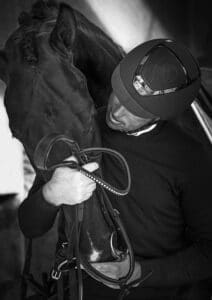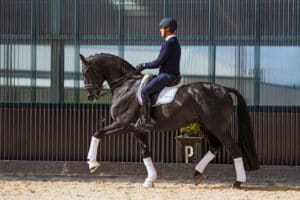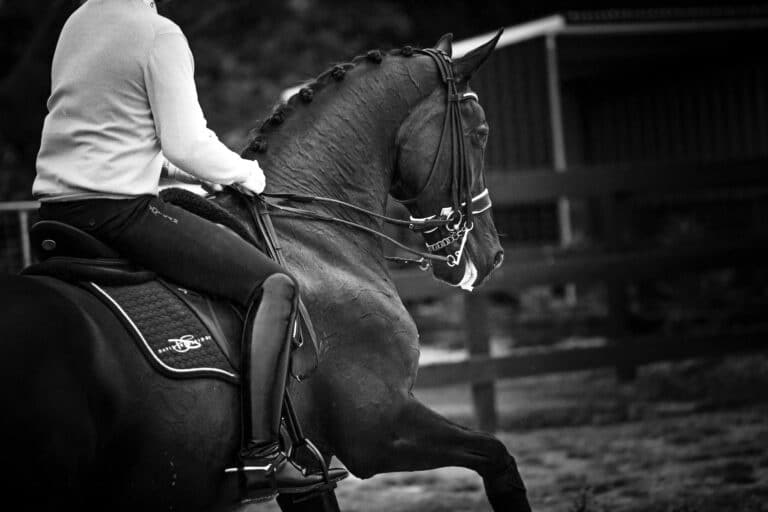How do you know when to transition from one bit to two? RACHEL ROAN spoke to elite dressage rider and Equestrian Hub mentor David Shoobridge.
Introducing your horse to a double bridle can mark a milestone in your training together. But adding a second bit into the mix has to be done with great consideration, care, and patience. It’s important that your horse is at the stage in their education where they are working well and are established in a snaffle bit. If this foundation is solid, the transition to two bits should be seamless. “If your horse has had any anxiety around a single bit, don’t be in a hurry to move to a double,” is the expert advice from elite dressage rider and coach, David Shoobridge. “Sometimes the long road gets you there the fastest.”
David explains his thoughts behind setting a horse up for a successful transition to a double bridle, emphasising the importance of a correct foundation: “The snaffle bit is always the baseline for communication. We want our horses to work positively into the contact. When you touch the rein, you don’t want your horse to be fearful of it, nor do you want them to take advantage of it. The horse needs to draw from our legs. A good contact comes back to a good position, and a good go and stop aid.”
Ensuring your horse works forward into the contact to carry themselves and their rider is a foundational step that needs to be in place before you consider transitioning. “It’s really vital that people understand the basis around establishing a good connection,” he reiterates.

Always treat your horse with respect.
Before starting on lateral movements, David recommends that the next step should be to develop correct transitions between the gaits, all while ensuring the horse is drawing forward into the snaffle bit. “It’s important that before we introduce the double bridle, the horse is working confidently and accepting a snaffle bit. And it’s really important that the rider, when introducing the double bridle, is not using it as a tool for discipline or control,” he adds. “If you feel you can’t ride your horse in a snaffle, then you need to revisit some of the basic applications of your training.”
Part of David’s approach to familiarising a horse to a double is to ride four days a week in the snaffle, and one day a week in the double. “When I introduce the double bridle, I have a very easy ride the first day, sometimes even just at a walk to let the horse adjust to the feel of two bits in their mouth.” He includes walks out of the arena, stretching, working at a walk, focusing on bend, and helping the horse to feel and accept the different pressure, adding that each horse and rider will develop their own plan.
The double bridle consists of the bridoon bit (snaffle) and the curb (Weymouth). When correctly fitted and accepted, the horse should still draw into the contact on the snaffle rein, with the curb acting as a lever by placing pressure on the poll. “The lever action of the curb will round the horse’s frame. It doesn’t really benefit any movement, it just refines the connection,” David says. “Going from a snaffle to a double bridle is not going to change how you do a flying change or half pass,” he explains. “It might allow for more control, or concise and precise timing, but it all comes back to the person at the end of the rein.”

David and his magnificent stallion Toto Nation de Jeu.
He believes it’s important for the rider to understand the purpose of the curb bit and how it works. “The curb bit puts pressure on the tongue and the bars of the mouth, the chin, and the poll. The horse isn’t going to want to move out of that frame, and there’s an element of pressure and release to maintain the frame you’ve got the horse in.”
David says it is critical to remember that the horse has not felt this pressure before, and riders should focus on encouraging the horse forward to the snaffle bit. However, the curb bit and rein should not be totally loose either, which might result in the bit bouncing around in the horse’s mouth. “It’s always good to have a consistent soft, light contact. Read the horse. Read their mannerisms and see if they’re happy and responding to it. If the transition from snaffle to double has gone well, it will be seamless,” he remarks.
If the horse is not adjusting well to the double bridle, it’s likely you will see resistance to the contact or potential tongue issues, especially if the bit is not fitting well. “You want to avoid pressure on the horse’s mouth and tongue,” David explains, “which can cause the horse to suck the tongue back, exposing the bit to the bars of the mouth and pallet.” Other signs of resistance and tension include the horse poking its tongue out of the side of their mouth, opening the mouth, or grabbing the bit.
If issues arise when transitioning, David’s suggestion is for the rider to reassess their training system, and look for the holes. “Ask yourself: What have I overlooked? What have I missed? Do I need to get some professional help and seek someone else’s opinion on this transition?” Resistance indicates that the rider may have been a little bit too quick to transition their horse. “If your horse does develop a mouth issue in a double – and I can’t stress this enough – it always comes back to training. The rider needs to look inside their system and work out where the flaws might be, seek help, and adjust what they’re doing.”

Some of David’s students introduce their young horses to the double in a lesson.
Honest reflection on the rider’s part is also necessary, and they should stop to consider whether they are the ones in need of education, not the horse. If you haven’t ridden in a double bridle before, David recommends getting a feel for it on a schoolmaster if the chance presents itself. “While not always readily accessible, the opportunity to try the high levels with a schoolmaster is an invaluable experience.”
The requirement to use a double bridle in competition varies depending on the class you enter and your location. David tells me that in recent years, Equestrian Australia has approved the use of a snaffle bridle all the way to Grand Prix. “For international classes though, the double bridle is mandatory at Prix St George and above,” he adds. “Previously, it was at medium level that you could decide between the snaffle or double, whereas now you can ride at any level in a double, as long as you’re not in an international class.”
The ultimate goal throughout the transition process is to maintain the horse’s comfort and happiness. This requires the rider to have significant self-discipline, knowing when to seek help rather than looking for a quick fix. “The crux of any transition or introduction of gear is that it’s absolutely imperative that riders understand the ramifications of misuse of any product or aid,” David warns. “Equally, they need to understand the benefits. What are you trying to achieve by changing the bit or equipment? Is that reflective of your basic aids and the basic communication that you have between your horse and yourself?”
Those considerations aside, the benefits of a double bridle are not to be overlooked. “Double bridles are a lovely tool to be used at a higher level,” he says. “They should be used with respect and the horse should always be ridden with respect. When done properly, it’s a fantastic feel. The horses are light, and when they accept the bit, we see what we call ‘ice cream’ – the froth from saliva in their mouth.”

If your horse is working well and established in a snaffle bit, the transition to two bits should be seamless.
A correctly fitted bridle should have minimal impact on the horse. The variation in types of bits and their fit is extensive, so it’s important to be prepared for some trial and error in finding the right combination. “There are a plethora of variations – that’s a topic in its own right!” David laughs. “Nowadays, most saddleries have bitting specialists you can consult for advice. You can often trial bits to find the right one to suit the conformation of the horse’s mouth, the level of the rider, and how the horse is going.”
Be prepared for some experimentation during this process and take the time to ensure your chosen bridle and bits fit correctly. When introducing the double bridle, riders should ideally work alongside an experienced coach who can offer an on-ground perspective. “Even the most experienced riders will seek another set of eyes on the ground to read the horse’s cues, to look at the contact, to see the mouth, what’s happening with the tongue, see the connection, and provide feedback,” notes David. “Some of my students who ride Grand Prix will quite often introduce their young horses to the double for the first time in a lesson.”
If done correctly, with patience, and with the basics of your training firmly established, introducing the double bridle to your horse should not only be a seamless process, but one that is an enjoyable and exciting time as you progress in your training journey.
To learn more about David’s training, coaching and breeding business, visit his website or enquire by email.
All images by Jessica Atkins Studio



